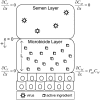Dynamics of HIV neutralization by a microbicide formulation layer: biophysical fundamentals and transport theory
- PMID: 16815899
- PMCID: PMC1557566
- DOI: 10.1529/biophysj.106.086322
Dynamics of HIV neutralization by a microbicide formulation layer: biophysical fundamentals and transport theory
Abstract
Topical microbicides are an emerging HIV/AIDS prevention modality. Microbicide biofunctionality requires creation of a chemical-physical barrier against HIV transmission. Barrier effectiveness derives from properties of the active compound and its delivery system, but little is known about how these properties translate into microbicide functionality. We developed a mathematical model simulating biologically relevant transport and HIV-neutralization processes occurring when semen-borne virus interacts with a microbicide delivery vehicle coating epithelium. The model enables analysis of how vehicle-related variables, and anti-HIV compound characteristics, affect microbicide performance. Results suggest HIV neutralization is achievable with postcoital coating thicknesses approximately 100 mum. Increased microbicide concentration and potency hasten viral neutralization and diminish penetration of infectious virus through the coating layer. Durable vehicle structures that restrict viral diffusion could provide significant protection. Our findings demonstrate the need to pair potent active ingredients with well-engineered formulation vehicles, and highlight the importance of the dosage form in microbicide effectiveness. Microbicide formulations can function not only as drug delivery vehicles, but also as physical barriers to viral penetration. Total viral neutralization with 100-mum-thin coating layers supports future microbicide use against HIV transmission. This model can be used as a tool to analyze diverse factors that govern microbicide functionality.
Figures





References
-
- UNAIDS. 2006. AIDS Epidemic Update. UNAIDS, Geneva, Switzerland.
-
- Brown, H. 2004. Marvellous microbicides. Lancet. 363:1042–1043. - PubMed
-
- Shattock, R., and S. Solomon. 2004. Microbicides—aids to safer sex. Lancet. 363:1002–1003. - PubMed
-
- Stone, A. 2002. Microbicides: a new approach to preventing HIV and other sexually transmitted infections. Nat. Rev. Drug Discov. 1:977–985. - PubMed
-
- Haase, A. T. 2005. Perils at the mucosal front lines for HIV and SIV and their hosts. Nature Rev. Immunol. 5:783–792. - PubMed
Publication types
MeSH terms
Substances
Grants and funding
LinkOut - more resources
Full Text Sources
Medical

